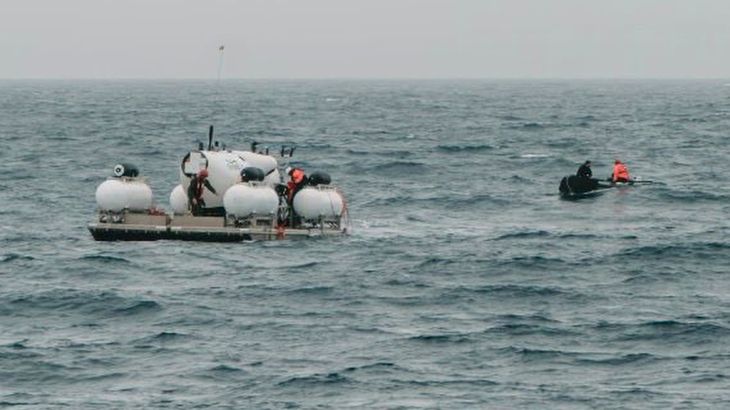Crews race to find Titanic sub lost in vast North Atlantic
US Coast Guard official says authorities are conducting ‘complex search effort’ with 40 hours of oxygen left in vessel.

Washington, DC – Search and rescue crews are racing under challenging conditions to locate a submersible vessel that had been exploring the wreckage of the Titanic before it went missing in the Atlantic Ocean, a United States coastguard official says.
Captain Jamie Frederick told reporters on Tuesday that the US coastguard and navy, the Canadian military and coastguard, and the vessel’s parent company, OceanGate Expeditions, are working under a unified command to conduct the search.
Keep reading
list of 3 itemsFirst full-sized 3D scan of the Titanic shipwreck captured
‘A challenge’: Crews search for missing Titanic tourist sub
“This is a complex search effort, which requires multiple agencies with subject matter expertise and specialised equipment,” Frederick said.
He said about 1pm (17:00 GMT) that the vessel with five people onboard had about 40 hours of oxygen left in it, stressing that the immediate priority is to find it. The sub originally had a 96-hour oxygen supply before it went missing on Sunday.
“The unified team is working around the clock to bring all available assets and expertise to bear as quickly as possible in an effort to solve this very complex problem,” he said.
Frederick pledged to continue with the “unwavering” push to locate the vessel, named Titan. He added that there is a “full-court press effort” to get equipment needed for the search.
The OceanGate expedition costs $250,000 per person. Its trip starts in St John’s in the Canadian province of Newfoundland before heading out to the Titanic wreckage site hundreds of kilometres to the east, the company’s website shows.
The passengers on the missing vessel are: Pakistani-British Shahzada Dawood and his 19-year-old son, Suleman; British billionaire Hamish Harding; Paul-Henri Gargeolet, a 77-year-old French explorer; and Stockton Rush, the founder and CEO of OceanGate Expeditions, which is based in the US.
On Tuesday, Frederick said search crews had covered 20,000sq km (7,600sq miles) since Sunday – “an area larger than the state of Connecticut”.
“It’s a unique operation; it’s a challenging operation. But right now, we’re focused on putting everything we can at it and searching as hard as we can and getting assets out there as quickly as we can,” Frederick said.
He said aircraft have searched the surface of the water as well as undersea by using sonar buoys.
Asked whether the search and rescue crews have the ability to retrieve the vessel if it is found, Frederick said, “Right now, all of our efforts are focused on finding the sub. What I will tell you is we have a group of our nation’s best experts in the unified command, and if we get to that point, those experts will be looking at what the next course of action is.”
Another US coastguard official told reporters that visibility was limited on Monday because of fog but it was improving on Tuesday.
White House national security spokesperson John Kirby told reporters later on Tuesday that President Joe Biden is following the search operation closely.
“The president wants the coastguard to continue to participate in that, and the navy is on standby if they’re needed because they have some deep water capabilities that the coastguard wouldn’t necessarily have,” Kirby said.